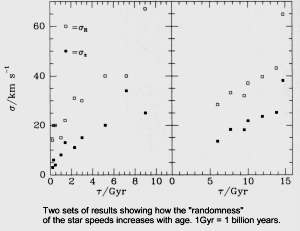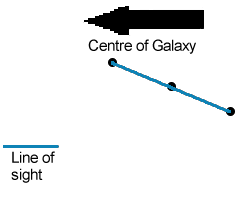The solar neighbourhood
We live quite far out in a typical giant galactic disk.  Most of the luminosity in the Universe is emitted by stars that are similarly located, so ours is an important environment to understand. Because we live right inside the Galactic disk, we can study its composition and how it functions in unique detail.
Most of the luminosity in the Universe is emitted by stars that are similarly located, so ours is an important environment to understand. Because we live right inside the Galactic disk, we can study its composition and how it functions in unique detail.
Composition of the galactic disk
The Galactic disk is made up of several distinct components. The thinnest is the disk formed by cold gas.
 The temperature of this material is only about 20 degrees above absolute zero. It is mostly made up of molecules of hydrogen, atoms of helium and molecules of a range of noxious gases such as carbon monoxide, hydrogen cyanide and carbon sulfide. Water and methyl alcohol are also abundant. The gas is extremely opaque because mixed in with it are zillions of tiny particles of the sort that makes smoke from a coal fire opaque. Astronomers say the opacity is caused by `dust', but `smoke' would be a more fitting name, not least because most of it has been pumped into the interstellar gas by worn-out stars, which smoke just like a worn-out diesel engine or a wet bonfire. The disk of molecular gas is about 200 light years thick.
The temperature of this material is only about 20 degrees above absolute zero. It is mostly made up of molecules of hydrogen, atoms of helium and molecules of a range of noxious gases such as carbon monoxide, hydrogen cyanide and carbon sulfide. Water and methyl alcohol are also abundant. The gas is extremely opaque because mixed in with it are zillions of tiny particles of the sort that makes smoke from a coal fire opaque. Astronomers say the opacity is caused by `dust', but `smoke' would be a more fitting name, not least because most of it has been pumped into the interstellar gas by worn-out stars, which smoke just like a worn-out diesel engine or a wet bonfire. The disk of molecular gas is about 200 light years thick.
The next thickest component of the Galactic disk is formed by gas at temperatures between 100 and 10,000 degrees above absolute zero. This gas is less dense than the molecular gas and therefore less opaque.
 Because it is less opaque, more ultraviolet radiation (what makes you go brown in the sun) from stars is able to reach right into this gas. This radiation splits apart any molecules it encounters, so this warmer gas does not contain many molecules, being made up of atoms of hydrogen, helium, and, in much smaller quantity, heavier elements. The disk of atomic gas is a little over 1000 light years thick.
Because it is less opaque, more ultraviolet radiation (what makes you go brown in the sun) from stars is able to reach right into this gas. This radiation splits apart any molecules it encounters, so this warmer gas does not contain many molecules, being made up of atoms of hydrogen, helium, and, in much smaller quantity, heavier elements. The disk of atomic gas is a little over 1000 light years thick.
Most of the mass of the Galactic disk is contained in stars rather than gas.
 The youngest stars are confined to a layer that is about as thick as the layer of atomic gas. Some of these young stars are significantly more massive than the Sun. Such stars are extremely luminous and usually very blue. In external galaxies these objects trace out spiral arms. They are the main source of the ultraviolent radiation that plays an important role in controlling interstellar gas.
The youngest stars are confined to a layer that is about as thick as the layer of atomic gas. Some of these young stars are significantly more massive than the Sun. Such stars are extremely luminous and usually very blue. In external galaxies these objects trace out spiral arms. They are the main source of the ultraviolent radiation that plays an important role in controlling interstellar gas.
The youngest stars form a thin disk because they are all on nearly circular orbits about the Galactic centre.
 As a star ages it is buffeted by the gravitational fields of gas clouds and spiral arms, with the result that its orbit tends to become less precisely circular and less precisely confined to the Galactic plane. Consequently, the disk formed by all the stars that formed at a given epoch grows steadily thicker over time. The very oldest stars form a disk that is 6000 light years thick. Although it is not a young star (about 4.5 Gyr old) the Sun happens to lie very close to the Galactic plane (about 45 light year north of it), and stars that belong to a thick disk whizz past us quite fast in their oscillations from the top to the bottom edge of their disk. Conversely, stars that belong to a thin disk come past quite slowly as they complete their lower-amplitude oscillations. Hence, the velocity dispersion of a stellar population increases with its age.
As a star ages it is buffeted by the gravitational fields of gas clouds and spiral arms, with the result that its orbit tends to become less precisely circular and less precisely confined to the Galactic plane. Consequently, the disk formed by all the stars that formed at a given epoch grows steadily thicker over time. The very oldest stars form a disk that is 6000 light years thick. Although it is not a young star (about 4.5 Gyr old) the Sun happens to lie very close to the Galactic plane (about 45 light year north of it), and stars that belong to a thick disk whizz past us quite fast in their oscillations from the top to the bottom edge of their disk. Conversely, stars that belong to a thin disk come past quite slowly as they complete their lower-amplitude oscillations. Hence, the velocity dispersion of a stellar population increases with its age.
Stellar velocities
The speed with which gas and young stars orbit around the Galactic centre is nearly independent of their distances from the Galactic centre. (This situation contrasts strongly with the Solar System, in which the speed of a planet is inversely proportional to the square root of its distance from the Sun.) Consequently, the time it takes a star to go once around the Galaxy (about 200 Myr for the Sun) increases outwards, being proportional to distance from the centre. So stars nearer the Galactic centre than the Sun are constantly overtaking the Sun, which is itself constantly overtaking stars that are further out. If we focus on a small patch around the Sun, this overtaking  while being overtaken manifests itself as the velocity field characteristic of a shearing medium, such as the layer of water next to the hull of a moving ship. We can measure this shear in several ways because it generates a characteristic pattern along the band in the sky of the Milky Way of line-of-sight velocities and proper motions for gas clouds and stars. It was by recognizing this pattern in the proper motions of stars that Jan Oort first demonstrated that we live in a spiral galaxy and determined its rotation rate. The key numbers that characterize the local shear field are called Oort constants in his honour.
while being overtaken manifests itself as the velocity field characteristic of a shearing medium, such as the layer of water next to the hull of a moving ship. We can measure this shear in several ways because it generates a characteristic pattern along the band in the sky of the Milky Way of line-of-sight velocities and proper motions for gas clouds and stars. It was by recognizing this pattern in the proper motions of stars that Jan Oort first demonstrated that we live in a spiral galaxy and determined its rotation rate. The key numbers that characterize the local shear field are called Oort constants in his honour.
Recently it has emerged that the picture of the solar neighbourhood that we have sketched is inadequate. When the astrometric satellite Hipparcos measured the distances and proper motions of about 100,000 stars, it emerged that the solar neighbourhood is significantly more complicated. The component of a star's velocity towards the Galactic centre is denoted by U while that in the direction of Galactic rotation is denoted by V. When the density of stars was plotted in the plane in which the coordinates are U and V, it turned out that the distribution is full of clumps
One stream of old stars probably is understood. It is formed by stars whose orbits happen to resonate with the Galactic bar. As a result of this resonance, the bar systematically increases the amplitude of their radial oscillations up to large values. These oscillations now carry the stars from radii similar to the length of the bar (about 9 million light years) to the location of the Sun (24 million light years) and beyond.
The mass of the galactic disk
A key question is: how much of the Galaxy's mass does the disk contain? - the rest must reside in the dark halo. We can answer this question by observing the motions of stars perpendicular to the disk: the more massive the disk is, the stronger the pull it exerts gravitationally on a star that lies above the Galactic plane, and the faster a star has to be going if it is to reach a given height above the plane in the course of its oscillations about the plane. The mass density at the mid-plane has recently been determined from Hipparcos data in this way (Creze et. al. 1998) and found to be 0.076 solar masses per cubic parsec or 5.2 x 10-21 kg per cubic metre. This agrees very well with the density calculated by making an inventory of the stars and gas near the Sun. Thus dark matter does not make a significant contribution to the local density.
Observations of the line-of-sight velocities of stars that lie over 100 light years from the galactic plane, (Kuijken & Gilmore 1991) determined the amount of mass per unit area in a column that passes right through the Galactic disk: 70 solar masses per square parsec. Stars and gas account for about 70% of this density. These findings are consistent with the dark matter density being approximately spherically distributed, so that it is small compared to the density of the disk in the Galactic plane, and becomes more and more important as one moves away from the plane.
